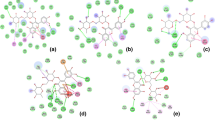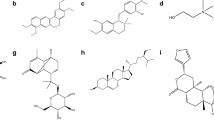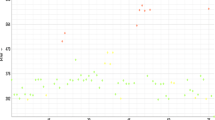Abstract
Ginger (Zingiber officinale Rosc.) is a popular spice used globally in ethnic cuisines and witnessed its extensive use in traditional medicine. In this study, we identified 12 phytochemicals from the ginger rhizome extract (hexane) through GC/MS analysis. After evaluating drug-likeliness, these phytochemicals were docked with 16 target proteins in silico, and docking scores were compared with their respective control drugs. Furthermore, multivariate statistical analysis (principal component analysis-PCA) was performed, and three different chemical clusters were identified. Pharmacophore analysis further identified common functional descriptors in the compounds under study. Finally, we developed a unique three-level network taking phytochemicals, target proteins and associated diseases based on the optimum docking scores. Overall, Oleic acid, Palmitic acid and Shogaol showed the highest coverage to the target proteins (12, 10 and 9 targets, respectively) and Oleic Acid scored the highest (5956) in PatchDock when docked against Peroxisome proliferator-activated receptor gamma (PDB id 1KNU, UniProt id P37231). This work provided significant insight into developing the protocol for rapid identification of potential drug likeliness of the identified phytochemicals.
Graphic abstract









Similar content being viewed by others
References
Al-Shudiefat AA-R (2013) Protective role of olive oil and its major component oleic acid in TNF-α induced remodeling subsequent to myocardial infarction in rats: University of Manitoba
Blasig I, Dickens B, Weglicki W et al (1996) Uncoupling of mitochondrial oxidative phosphorylation alters lipid peroxidation-derived free radical production but not recovery of postischemic rat hearts and post-hypoxic endothelial cells. Biochem Mech Heart Funct 1996:167–177
Bundesanzeiger B (1998) Monographien der Kommission E (Zulassungs-und Aufbereitungskommission am BGA fr den humanmed. Bereich, chytotherapeutische Therapierichtung und Stoffgruppe). Köln: Bundesgesundheitsamt (BGA)
Chandran U, Patwardhan B (2017) Network ethnopharmacological evaluation of the immunomodulatory activity of Withania somnifera. J Ethnopharmacol 197:250–256
Choudhary N, Singh V (2018) A census of P. longum’s phytochemicals and their network pharmacological evaluation for identifying novel drug-like molecules against various diseases, with a special focus on neurological disorders. PLoS ONE 13(1):e0191006
Constantinides PP, Chakraborty S, Shukla D (2016) Considerations and recommendations on traditional and non-traditional uses of excipients in oral drug products. AAPS Open 2(1):3
Daina A, Michielin O, Zoete V (2017) SwissADME: a free web tool to evaluate pharmacokinetics, drug-likeness and medicinal chemistry friendliness of small molecules. Sci Rep 7:42717
Dey P, Sarkar I, Dutta S et al (2019) Correlative metabolomic fingerprinting and molecular docking studies of dermatological phytotherapeutics of South-Eastern Himalaya. J Tradit Complement Med 9(4):243–248
Duhovny D, Nussinov R, Wolfson H (2002) Proceedings of the 2'nd workshop on algorithms in bioinformatics (WABI) Rome, Italy, Lecture Notes in Computer Science
Ertl P, Rohde B, Selzer P, Jomc J (2000) Fast calculation of molecular polar surface area as a sum of fragment-based contributions and its application to the prediction of drug transport properties. J Med Chem 43(20):3714–3717
Feunang YD, Eisner R, Knox C et al (2016) ClassyFire: automated chemical classification with a comprehensive, computable taxonomy. J Cheminform 8(1):61
Fung TT, Rexrode KM, Mantzoros CS et al (2009) Mediterranean diet and incidence and mortality of coronary heart disease and stroke in women. Circulation 119(8):1093
Ghaeidamini MH, Rahgozar S, Rahimi SB et al (2020) Fatty acid synthase, a novel poor prognostic factor for acute lymphoblastic leukemia which can be targeted by ginger extract. Sci Rep 10(1):1–13
Giuliani A (2017) The application of principal component analysis to drug discovery and biomedical data. Drug Discovery Today 22(7):1069–1076
Guo J-B, Fan Y, Zhang W-J et al (2017) Extraction of gingerols and shogaols from ginger (Zingiber officinale Roscoe) through microwave technique using ionic liquids. J Food Compos Anal 62:35–42
Hassanpouraghdam MB, Aazami MA, Shalamzari MS et al (2011) Essential oil composition of Zingiber officinale Rosc. rhizome from the Iranian herb market. Chemija 22(1):56–59
Huang Q, Zhang F, Liu S et al (2021) Systematic investigation of the pharmacological mechanism for renal protection by the leaves of Eucommia ulmoides Oliver using UPLC-Q-TOF/MS combined with network pharmacology analysis. Biomed Pharmacother 140:111735
Imazio M, Adler Y (2013) Treatment with aspirin, NSAID, corticosteroids, and colchicine in acute and recurrent pericarditis. Heart Fail Rev 18(3):355–360
Islam R, Parves MR, Paul AS et al (2020) A molecular modeling approach to identify effective antiviral phytochemicals against the main protease of SARS-CoV-2. J Biomol Struct Dyn 2020:1–12
Jiang L-R, Qin Y, Nong J-L et al (2021) Network pharmacology analysis of pharmacological mechanisms underlying the anti-type 2 diabetes mellitus effect of guava leaf. Arab J Chem 14(6):103143
Jolliffe IT, Cadima J (2016) Principal component analysis: a review and recent developments. Philos Trans R Soc Math Phys Eng Sci 374(2065):20150202
Kaleem M, Asif M, Ahmed Q et al (2006) Antidiabetic and antioxidant activity of Annona squamosa extract in streptozotocin-induced diabetic rats. Singapore Med J 47(8):670
Karnick C (1994) Pharmacopoeial standards of herbal plants, vol I. Sri Satguru Publications, New Delhi
Kartasasmita RE, Tjahjono DHJF (2021) Virtual screening of curcumin analogues as DYRK2 inhibitor: pharmacophore analysis, molecular docking and dynamics, and ADME prediction. F1000 Res 10(394):394
Kou X, Ke Y, Wang X et al (2018) Simultaneous extraction of hydrophobic and hydrophilic bioactive compounds from ginger (Zingiber officinale Roscoe). Food Chem 257:223–229
Lever J, Krzywinski M, Altman N (2017) Points of significance: Principal component analysis. Nature Publishing Group, Berlin
Li Y, Guo C, Yang J et al (2006) Evaluation of antioxidant properties of pomegranate peel extract in comparison with pomegranate pulp extract. Food Chem 96(2):254–260
Lipinski CAJDDTT (2004) Lead-and drug-like compounds: the rule-of-five revolution. Drug Discov Today Technol 1(4):337–341
Mannhold R, Poda GI, Ostermann C et al (2009) Calculation of molecular lipophilicity: State-of-the-art and comparison of log P methods on more than 96,000 compounds. J Pharmaceutic Sci 98(3):861–893
Nag A, Das RJRJoB (2020) Beta carotene inhibiting HIV-1 reverse transcriptase, an in silico approach. J Pharmaceutic Sci 15(1):69–73
Nishidono Y, Saifudin A, Deevanhxay P et al (2020) Metabolite profiling of ginger (Zingiber officinale Roscoe) using GC-MS and multivariate. Stat Anal 2:1–14
Oforma C, Udourioh G, Ojinnaka C (2019) Characterization of essential oils and fatty acids composition of stored ginger (Zingiber officinale Roscoe). J Appl Sci Environ Manag 23(12):2231–2238
Patras A, Brunton NP, Downey G et al (2011) Application of principal component and hierarchical cluster analysis to classify fruits and vegetables commonly consumed in Ireland based on in vitro antioxidant activity. J Food Compos Anal 24(2):250–256
Ponnulakshmi R, Vishnupriya V, Mohan SK et al (2020) Molecular docking analysis of alkaloid compounds with beta-catenin towards the treatment of colon cancer. Bioinformation 16(3):283
Poonkuil NL, Raja JD (2017) Drying effects on ultrasonic assisted phenolic yields and retentiveness of antiradical properties of common culinary spices ginger (Zingiber officinale) and turmeric (Curcuma longo): HPTLC and GC-MS profile for their active ingredients assessment. Int J Regul Gov 5(9):7–23
Prabhu S, Rajeswari VD (2016) In silico docking analysis of bioactive compounds from Chinese medicine Jinqi Jiangtang tablet (JQJTT) using patch dock. J Chem Pharm Res 5(8):15–21
Quan PM, Binh VN, Ngan VT et al (2019) Molecular docking studies of Vinca alkaloid derivatives on Tubulin. Vietnam J Chem 57(6):702–706
Rampogu S, Baek A, Gajula RG et al (2018) Ginger (Zingiber officinale) phytochemicals—gingerenone-A and shogaol inhibit SaHPPK: molecular docking, molecular dynamics simulations and in vitro approaches. Ann Clin Microbiol 17(1):1–15
Salea R, Veriansyah B, Tjandrawinata RR (2017) Optimisation and scale-up process for supercritical fluids extraction of ginger oil from Zingiber officinale var. Amarum. J Supercritical Fluids 120:285–294
Schneidman-Duhovny D, Inbar Y, Nussinov R et al (2005) PatchDock and SymmDock: servers for rigid and symmetric docking. Nucleic Acids Res 33(Suppl_2):W363–W367
Schneidman-Duhovny D, Dror O, Inbar Y et al (2008) Deterministic pharmacophore detection via multiple flexible alignment of drug-like molecules. J Comput Biol 15(7):737–754
Sharifi-Rad J, Salehi B, Stojanović-Radić ZZ et al (2020a) Medicinal plants used in the treatment of tuberculosis-Ethnobotanical and ethnopharmacological approaches. Biotechnol Adv 2020:107629
Sharifi-Rad J, El Rayess Y, Abi Rizk A et al (2020b) Turmeric and its major compound curcumin on health: bioactive effects and safety profiles for food, pharmaceutical, biotechnological and medicinal applications. Front Pharmacol 11:01021
Sharma S, Malla S (2020) Molecular docking studies of podophyllotoxin and its derivatives against metabolic enzymes regarding anticancer therapeutic strategies. Recent Adv Biol Med 6(2):12742
Shoba K, Kalpana K (2019) Protein modeling and drug docking studies on potential protein target (E. coli–dosP) and compound aldehyde (sumatriptan) using bioinformatics tools. Res Rev J Bioinf 5(3):9–18
Syafitri DM, Levita J, Mutakin M et al (2018) A review: IS ginger (Zingiber officinale var. Roscoe) potential for future phytomedicine? Indones J Appl Sci 8:1
Tohma H, Gülçin İ, Bursal E et al (2017) Antioxidant activity and phenolic compounds of ginger (Zingiber officinale Rosc.) determined by HPLC-MS/MS. J Food Meas Charact. 11(2):556–566
Tony M, Nag A (2019) Cu-Induced oxidative stress modifies the metabolic profile of Allium cepa roots. J Pharmacogn Phytochem 8(1):1281–1284
Vane J, Botting R (2003) The mechanism of action of aspirin. Thromb Res 110(5–6):255–258
Wang J, Zhang Y, Fang Z et al (2019) Oleic acid alleviates cadmium-induced oxidative damage in rat by its radicals scavenging activity. Biol Trace Elem Res 190(1):95–100. https://doi.org/10.1177/0960327110372402
Yang Z, Luo S, Peng Q et al (2009) GC-MS analysis of the essential oil of coral ginger (Zingiber corallinum Hance) rrhizome obtained by supercritical fluid extraction and steam distillation extraction. Chromatographia 69(7/8):785–790
Yocum GT, Hwang JJ, Mikami M et al (2020) Ginger and its bioactive component 6-shogaol mitigate lung inflammation in a murine asthma model. Am J Physiol Lung Cell Mol Physiol 318(2):L296–L303
Zhang M-M, Wang D, Lu F et al (2021) Identification of the active substances and mechanisms of ginger for the treatment of colon cancer based on network pharmacology and molecular docking. Biodata Mining 14(1):1–16
Author information
Authors and Affiliations
Corresponding author
Ethics declarations
Conflict of interest
The author declares that there is no conflict of interest.
Additional information
Publisher's Note
Springer Nature remains neutral with regard to jurisdictional claims in published maps and institutional affiliations.
Supplementary Information
Below is the link to the electronic supplementary material.
Rights and permissions
About this article
Cite this article
Nag, A., Banerjee, R. Network pharmacological evaluation for identifying novel drug-like molecules from ginger (Zingiber officinale Rosc.) against multiple disease targets, a computational biotechnology approach. Netw Model Anal Health Inform Bioinforma 10, 55 (2021). https://doi.org/10.1007/s13721-021-00330-6
Received:
Revised:
Accepted:
Published:
DOI: https://doi.org/10.1007/s13721-021-00330-6




